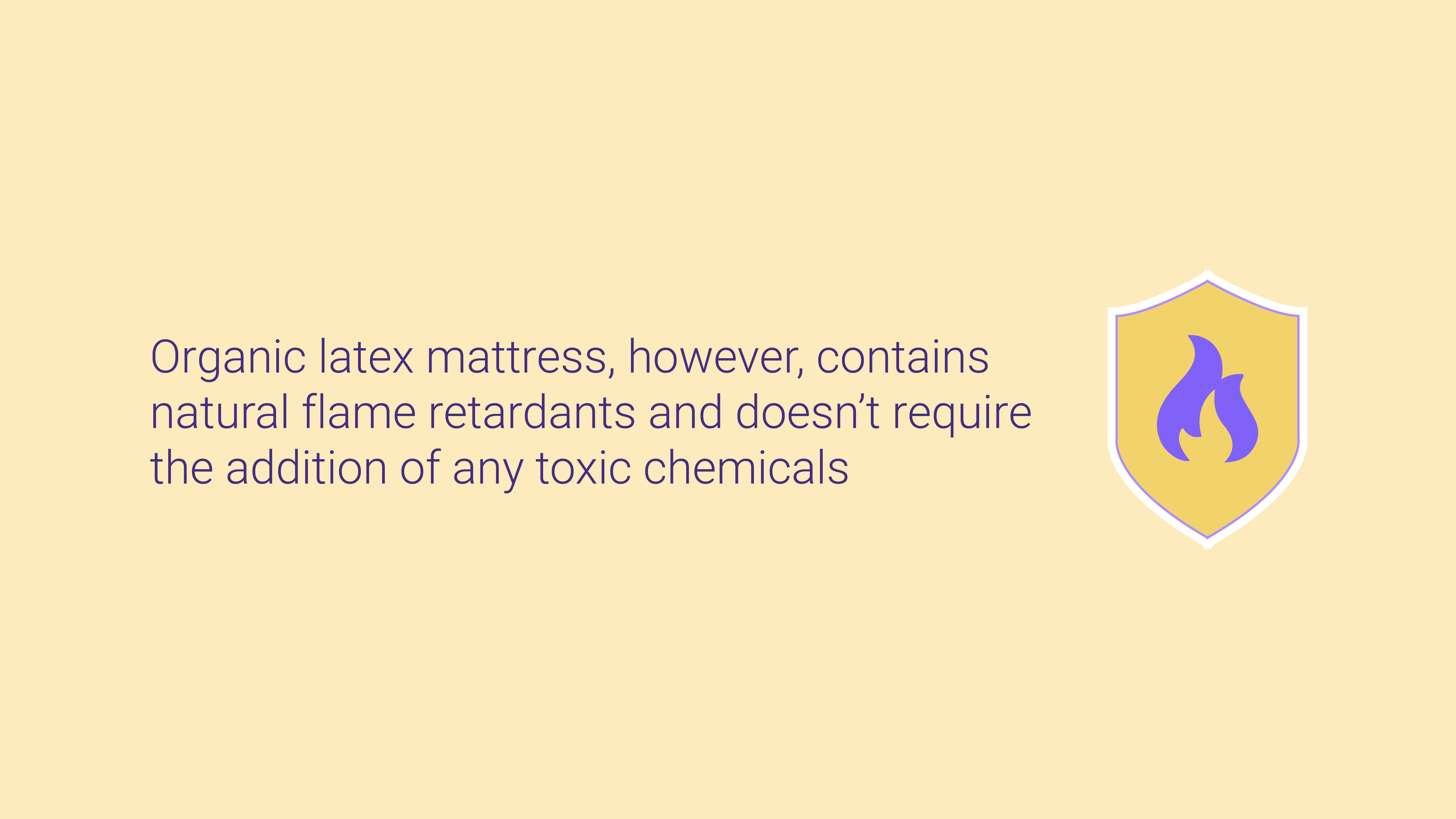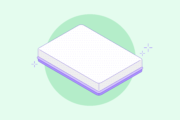
What Are the Benefits of a Latex Mattress?

- Natural latex mattresses are made from 100% natural latex, with the manufacturing process involving either Dunlop or Talalay methods. Dunlop results in a denser and heavier foam, while Talalay produces a softer, bouncier feel.
- Natural latex mattresses offer pain-relieving properties by providing responsive support, making them suitable for sleepers with back or joint pain. These mattresses are organic, eco-friendly, and use natural flame retardants, avoiding the need for toxic chemicals.
- Along with their contouring support, natural latex beds are also allergen-free, breathable, and highly durable. Latex mattresses can last between 10 to 20 years.
Latex is one of the most popular materials in mattresses because of the many benefits it offers. It’s highly durable, provides contouring support, and is ultra-breathable. Natural latex offers even more advantages including being hypoallergenic and environmentally friendly.
In this post, we’ll explain what latex is and the different types available, plus the various benefits you can expect from an all-natural latex mattress.
What is Latex?
Latex is an all-natural material harvested from the sap of rubber trees. The milky white substance has high elasticity and is used to make rubber and other products, including mattresses. While you can buy all-natural latex mattresses, others may be made from synthetic latex or a mix of the two.
When choosing between types of latex, we suggest sleepers opt for all-natural latex options because of the many benefits organic latex offers; however, those with latex allergies should avoid these beds altogether to reduce the risk of coming into contact with any allergen-causing proteins. Synthetic options can work for sleepers with latex allergies set on latex beds, but we suggest choosing a different type of mattress since synthetic latex foams are usually low quality and not long-lasting.
See our latex mattress buying guide for more information.
Natural
Natural latex mattresses are made using 100-percent natural latex. Since large amounts of latex are required to make one mattress, they are often very expensive.
After natural latex is harvested, there are two different ways it can be manufactured into a mattress: Dunlop and Talalay.
Dunlop vs. Talalay Latex
The Dunlop process starts out by whipping the sap into a foam before pouring the mixture into a mold and being baked. During this time, sediment in the mixture settles at the bottom of the mold, creating a firmer bottom. Finally, the foam is washed and dried. Dunlop foam creates a uniform product and is much denser and heavier than Talalay because it uses more latex.
The Talalay method is similar to Dunlop but is slightly more energy-intensive. Talalay also begins with the whipped foam, but in this process, it’s poured into a mold that’s partially filled. The mold is sealed and a vacuum then expands the latex to evenly fill the mold. Next, carbon dioxide is added to create a gel-like material. The mold is then frozen so particles do not have a chance to settle. Finally, it’s heated to 220 degrees Fahrenheit to set it. The foam is then washed and dried.
Talalay foam tends to be more expensive because it requires more energy to make than Dunlop. Talalay is also lighter in weight with a softer, bouncier feel.
Synthetic
Synthetic latex is artificially produced to mimic the look and feel of latex. It can be made from a variety of materials but is usually constructed from SBR (styrene-butadiene rubber). Synthetic latex mattresses are typically much more affordable than natural latex because they contain man-made materials. However, synthetic mattresses aren’t as durable as all-natural.
Another drawback is synthetic latex usually contains a lot of chemicals and additives and can emit strong, unpleasant odors. This is called off-gassing and can be very off-putting or even toxic.
Blended
Blended latex features a combination of 30 percent natural and 70 percent synthetic latex. A blended latex mattress may also emit a chemical smell when it’s new since it still contains synthetic materials. These mattresses will be somewhat more durable than purely synthetic mattresses, but not as durable as an all-natural latex mattress.
Benefits of a Natural Latex Mattress
All-natural latex mattresses provide the greatest benefits and are superior to synthetic or blended because they are much more durable and eco-friendly, and offer more health benefits.
Pain-Relieving
Latex foam conforms to the body by gently cradling heavier areas like the hips and shoulders; however, latex doesn’t sink below the weight of sleepers like memory foam. Instead, latex offers lifting, responsive support to reduce pain-causing pressure points. The high elasticity of latex also supports the neck and back to keep the spine in natural alignment. Sleepers with back or joint pain will especially benefit from the cushioning, yet the buoyant feel of latex.
Organic

Many mattresses require the addition of flame-retardant chemicals in order to meet regulations. These additives can off-gas and even cause long-lasting health issues. Many of these chemicals have been linked to cancer, infertility, headaches, respiratory issues, and other ailments. An organic latex mattress, however, contains natural flame retardants and doesn’t require the addition of any toxic chemicals.
There are plenty of non-chemical flame retardants, such as wool, plant-fibers, silica, and fiberglass. Some shoppers prefer a mattress without fiberglass because the material can irritate the skin if the mattress is removed, which is another plus of a latex mattress. Most latex beds rely on wool or silica as a fire barrier.
Eco-Friendly
Latex is derived from the sap of rubber trees, which can produce this sap for up to 30 years. During the harvesting process, the trees are not damaged in any way, and there is no use of petroleum products. In fact, harvesting the sap actually encourages the continuous planting of new rubber trees, making the process very sustainable.
It’s important to note while latex can be sustainably harvested, it’s not always manufactured responsibly. There are various certifications and labels to guarantee the eco-friendliness of a mattress. Some trusted certifications in the mattress industry include:
- Global Organic Latex Standard (GOLS): Guarantees latex is grown and processed organically
- Global Organic Textile Standard (GOTS): Requires manufacturers meet specific criteria for naturally grown textiles, like organic wool or organic cotton covers on latex mattresses
- eco-Institut: Certifies products have little to no emission levels
- OEKO-TEX Standard 100: Certifies products do not contain harsh chemicals
- GREENGUARD GOLD: This label promises low emission levels and little to no volatile organic compounds
Natural latex mattresses also reduce waste because they are fully recyclable. Mattresses can take up a lot of space in a landfill, so it’s important to recycle them if you can.
Allergen-Free
Latex is great for anyone who suffers from allergies because the material is inhospitable to dust mites, mildew, and mold. A hypoallergenic mattress offers multiple health benefits like alleviating allergy symptoms and providing less chemical exposure. Oftentimes, mattresses may be treated with certain chemicals to prevent bacteria and other infestations. This can lead to other health issues like respiratory problems and off-gassing.
All-natural latex mattresses should not be slept on by anyone with a latex allergy. Even though the allergen-causing proteins found in latex are virtually eliminated during manufacturing, there is still the chance these beds may trigger allergic reactions to those sensitive to latex.
Breathable
The natural open-cell structure of latex enhances airflow, making it very breathable. Latex mattresses are also punctured with small pinholes throughout, creating even more ways for air and heat to escape; increased airflow means a cooler, more comfortable sleep.
Durable
Latex is naturally very durable and resilient. Its responsiveness allows it to bounce back from pressure quickly and maintain its shape for many years. The average mattress lasts around seven years, while all-natural latex mattresses can last much longer.
A latex mattress lasts anywhere between 10 and 20 years.
FAQs
How does latex differ from memory foam?
Latex and memory foam share some similarities, for example, they both have a cushioning, cradling feel and reduce pain-causing pressure points. They also have a few slight differences; the main difference being memory foam is a cradling material and latex is lifting.
Memory foam was first created for NASA in the 1960s. It’s constructed of polyurethane foam and added chemicals. Memory foam mattresses are known for their great body-contouring capabilities and motion isolation. However, memory foam not as responsive as latex, and can leave some sleepers feeling “stuck”—though others may enjoy the extra cushion memory foam can offer.
Latex is made from the sap harvested from rubber trees. It’s naturally more breathable because of its porous structure and pinhole construction. The elasticity of latex offers more lift and buoyant support than memory foam, but still provides the desired cushioning effect. Sleepers enjoy a quicker bounce back with latex, making it responsive to movement and much more durable.
What are the cons of latex mattresses?
Latex mattresses, especially all-natural ones, can be very expensive because they require a lot of latex to make. While prices vary from brand to brand, a queen size all-natural latex mattress can cost up to $3,000. Another disadvantage is how heavy latex mattresses are. Due to their density, they can be very difficult to move, flip, or rotate.
Is latex safe to sleep on?
Latex is safe for most people to sleep on, especially because it’s naturally allergen-free and not treated with any chemicals or additives. However, anyone with a latex allergy should not sleep on latex beds. While the mattresses are repeatedly washed when being manufactured and many of the allergen-causing proteins are eliminated, there is still the possibility they can trigger allergies. Speak with your doctor first if you’re still considering a latex mattress.
What’s the difference between Talalay latex and Dunlop latex?
Talalay and Dunlop are two methods of manufacturing latex mattresses. Both processes begin by whipping the latex into a foam and pouring the mixture into a mold. With Dunlop, the mold is filled to the top and baked. With Talalay, the mold is filled halfway and then fully expanded by vacuum and injected with carbon dioxide. The mold is then frozen to prevent particles from settling before being baked to set it.
Dunlop is less expensive because it’s much more energy- and time-efficient than Talalay. The Talalay method however, creates a lighter, bouncier mattress since it contains more air than Dunlop.
Do natural latex mattresses smell?
Natural latex mattresses may give off a slight rubbery smell when new but they do not off gas, or emit chemical odors. When glue, petroleum, or other chemicals are used in the manufacturing process, like with synthetic or blended latex mattresses, they emit smells. These odors can be toxic or irritating, especially to anyone with respiratory problems. Since natural latex does not contain any additives, it does not off gas.
Conclusion
Latex mattresses may be pricey due to containing expensive materials, but they provide many attractive benefits for sleepers. Highly durable and naturally resilient, latex can maintain its shape for many years. The natural breathability of latex provides a more cooling sleep than other foam mattresses and its elasticity offers lifted support for the body.
Choosing an all-natural latex mattress over synthetic or blended offers even more perks like not emitting odors, being allergen-free, and sustainable. Remember to look for eco-friendly labels for all-natural mattresses to guarantee responsible harvesting and manufacturing.



